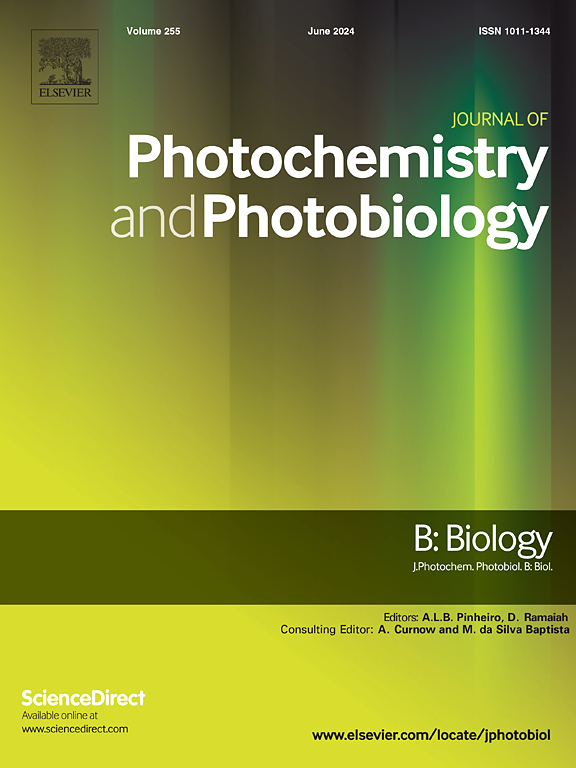Photobiomodulation presents an anti-inflammatory effect, reflecting on the expression of receptors related to the pain process in a collagenase-induced tendinitis experimental model
IF 3.7
2区 生物学
Q2 BIOCHEMISTRY & MOLECULAR BIOLOGY
Journal of photochemistry and photobiology. B, Biology
Pub Date : 2025-06-26
DOI:10.1016/j.jphotobiol.2025.113205
引用次数: 0
Abstract
Pain associated with tendinopathy is a common and difficult to treat. A therapeutic strategy to control some chronic painful processes is the use of benzodiazepines, which act on their GABA receptors, producing a sedative and analgesic effect. Non-pharmacological approaches, such as photobiomodulation (PBM), have shown promising results in the control of inflammatory joint pain. The aim of this study was to investigate the effects of combined treatment between PBM and Diazepam (DZP) in the control of the pain process, based on the evaluation of mechanical allodynia and the expression of GABA receptors (a1 and a2), neurokinin 1 (NK1) and bradykinin (B1), comparing with the activity of myeloperoxidase (MPO) and inflammatory tissue infiltrate, in an experimental model of tendinitis. Male Wistar rats were anesthetized with 1 % inhaled isoflurane (BioChimico®, lot 008694), and tendinitis was induced by transcutaneous injection of collagenase type I into the Achilles tendon region. In the first phase, after tendinitis induction, the time course of pain sensitivity was evaluated using the mechanical allodynia test. In the second phase, the rats were distributed into seven experimental groups: Healthy Control Group (CTL) and tendinitis Untreated (NT) or treated with PBM (808 nm, 3 J, 100 mW, 107 J/cm2); treated with DZP; treated with combined therapies (PBM + DZP); pre-treated with neutral GABA receptor modulator – Flumazenil (GABA receptor antagonist) followed by DZP (FLU+DZP); and pre-treated with FLU followed by PBM (FLU+PBM). Eight hours after tendinitis induction, with the development of tissue inflammation, mechanical allodynia in the Achilles tendon was evaluated. After the various treatments, the animals were euthanized with an anaesthetic overdose and the tendons were recovered for histological and biochemical analyses. Our results showed that treatment with PBM reduced MPO activity and gene expression of B1, NK-1, GABAα2 receptors, as well as increased mechanical allodynia and GABAα1 expression. PBM + DZP also reduced MPO activity, as well as the expression of B1, GABAα₁ receptors and improved mechanical allodynia. The FLU+PBM group altered the results presented by the single treatment with PBM. Our results show that PBM modulates the pain process by improving mechanical allodynia and decreasing the gene expression of B1, NK-1 receptors, and increasing GABAα1 gene expression. These findings suggest that pain modulation by PBM in the experimental tendinitis model may be related not only to the control of inflammation but also to the regulation of the expression of B1, NK-1, GABAα1 and GABAα2 receptors.
在胶原酶诱导的肌腱炎实验模型中,光生物调节表现出抗炎作用,反映了与疼痛过程相关的受体的表达
与肌腱病变相关的疼痛是一种常见且难以治疗的疾病。控制慢性疼痛过程的一种治疗策略是使用苯二氮卓类药物,它作用于GABA受体,产生镇静和镇痛作用。非药物方法,如光生物调节(PBM),在控制炎症性关节疼痛方面显示出有希望的结果。本研究的目的是通过评估机械异位性疼痛,GABA受体(a1和a2)、神经激肽1 (NK1)和缓激肽(B1)的表达,比较脊髓过氧化物酶(MPO)的活性和炎症组织浸润,探讨PBM和地西泮(DZP)联合治疗对肌腱炎过程的控制作用。采用1%吸入异氟醚(BioChimico®,批次008694)麻醉雄性Wistar大鼠,经皮向跟腱区注射I型胶原酶诱导肌腱炎。在第一阶段,肌腱炎诱导后,采用机械异常性疼痛试验评估疼痛敏感性的时间过程。在第二阶段,将大鼠分为7个实验组:健康对照组(CTL)和未治疗肌腱炎组(NT)或PBM (808 nm, 3 J, 100 mW, 107 J/cm2);DZP处理;联合治疗(PBM + DZP);用中性GABA受体调节剂氟马西尼(GABA受体拮抗剂)预处理后再用DZP (FLU+DZP)处理;流感和PBM (FLU+PBM)预处理。肌腱炎诱导后8小时,随着组织炎症的发展,评估跟腱的机械异位性疼痛。各种治疗后,动物被麻醉过量安乐死,并恢复肌腱进行组织学和生化分析。结果表明,PBM治疗可降低MPO活性和B1、NK-1、GABAα2受体的基因表达,增加机械异常性痛和GABAα1的表达。PBM + DZP还能降低MPO活性,以及B1、GABAα 1受体的表达,改善机械异常性痛。FLU+PBM组改变了单一PBM治疗的结果。我们的研究结果表明,PBM通过改善机械异常性疼痛,降低B1、NK-1受体的基因表达,增加GABAα1基因表达来调节疼痛过程。这些结果提示,PBM对实验性肌腱炎模型疼痛的调节可能不仅与炎症的控制有关,还与调节B1、NK-1、GABAα1和GABAα2受体的表达有关。
本文章由计算机程序翻译,如有差异,请以英文原文为准。
求助全文
约1分钟内获得全文
求助全文
来源期刊
CiteScore
12.10
自引率
1.90%
发文量
161
审稿时长
37 days
期刊介绍:
The Journal of Photochemistry and Photobiology B: Biology provides a forum for the publication of papers relating to the various aspects of photobiology, as well as a means for communication in this multidisciplinary field.
The scope includes:
- Bioluminescence
- Chronobiology
- DNA repair
- Environmental photobiology
- Nanotechnology in photobiology
- Photocarcinogenesis
- Photochemistry of biomolecules
- Photodynamic therapy
- Photomedicine
- Photomorphogenesis
- Photomovement
- Photoreception
- Photosensitization
- Photosynthesis
- Phototechnology
- Spectroscopy of biological systems
- UV and visible radiation effects and vision.

 求助内容:
求助内容: 应助结果提醒方式:
应助结果提醒方式:


